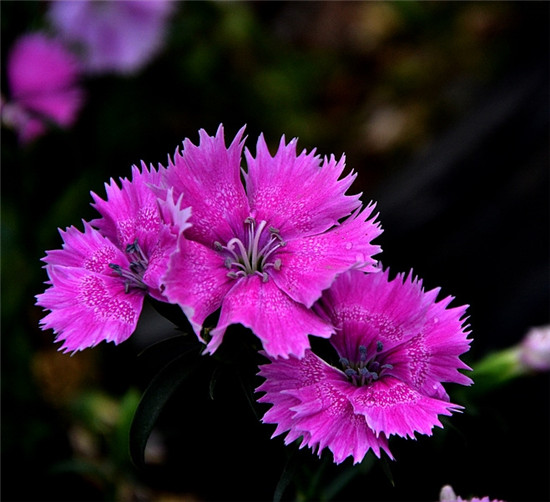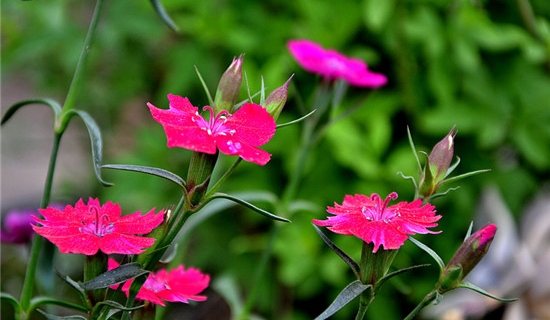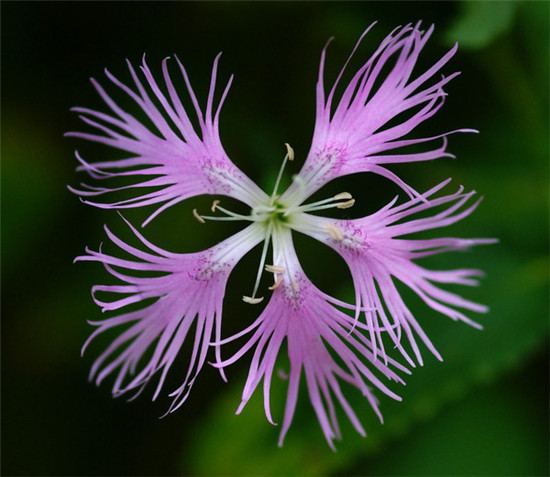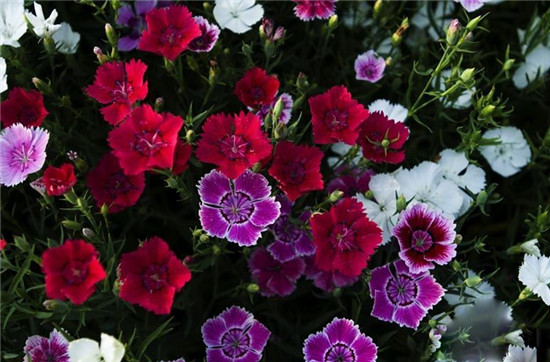[qu Mai] cultivation method of qu Mai
Dioscorea nigra is a perennial herb of Caryophyllaceae and Dianthus. It is a good material for arranging flower beds and flower borders, and it can also be potted or cut flowers. Next, let's take a look at the planting of barley.

Dioscorea nigra is a perennial herb of Caryophyllaceae and Dianthus. Caespitose stems, lanceolate leaves, gathering and scattered inflorescences, is a good material for arranging flower beds and flower borders, and can also be potted or cut flowers. The whole grass is used in medicine, which has the effect of relieving menstruation and diuresis.
Tall 30-60cm, stems tufted, erect, distally 2-branched, nodes dilated. Leaves opposite, linear to linear-lanceolate, apex acuminate, base into a short sheath-shaped clasping stem, entire or denticulate, two flour green. Flowers solitary or several integrated sparse Cymes, white, red or various shades of red or purple, fragrant. Bracts 4-6, broadly ovate, apex acute or acuminate, ca. 1 stroke as long as calyx tube; calyx cylindric, slender, apex 5-lobed; petal apex deeply divided into filiform, throat with bearded hairs; stamens 10; ovary 1-loculed, style 2. Capsule long tube-shaped, 4-toothed, with persistent calyx. Seeds flattened, black, margin with wings wider than seeds. The flowering period is from May to July and the fruiting period is from July to October.

Herbs perennial, 50-60 m tall, sometimes higher. Stems tufted, erect, green, glabrous, upper part branched. Leaf blade linear-lanceolate, 5-10 cm long, 3-5 mm wide, apex acute, midrib prominent, base connate into sheath-shaped, green, sometimes pinkish green. Flowers 1 or 2 branches apical, sometimes axillary below apex; bracts 2-3 pairs, Obovate, 6-10 mm long, ca. 1-beat 4, 4-5 mm wide, tip long-pointed; calyx cylindrical, 2.5-3 cm long, 3-6 mm in diameter, often dyed purplish red halo, calyx teeth lanceolate, 4-5 mm long Petals 4-5 cm long, claws 1.5-3 cm long, enclosed in calyx tube, limb broadly Obovate, margin lobed to middle or above, usually reddish or purplish, thin white, throat with filiform scales; stamens and style slightly exserted. Capsule cylindric, as long as or slightly longer than persistent calyx, apical 4-lobed; seeds oblate-ovoid, ca. 2 mm, black, glossy. The flowering period is from June to September and the fruiting period is from August to October.
Growth habits: like warm and humid environment, resistant to cold. It should be planted in fertile sandy loam or clayey loam.

Planting method: sowing and reproduction. It can be planted in spring, summer and autumn, and it is better in spring. First select the land, apply sufficient basic fertilizer, plough and make the border, strip sowing, row spacing 27 meters, draw 1 meter shallow trench to sow the seeds evenly, push flat with hoe, and cover the soil thin. When the temperature is 18-20 degrees, the seedlings will emerge in about 7 days.
Field management: go to the crowds after emergence. During the growing period, the soil should be loosened, weeded and watered in time to keep the soil moist. When the seedling is 10-15 cm high, 10 kg of urea is applied per mu. In the flowering season, increase the watering times appropriately. If harvested twice, water before harvest, do not water within 2-3 days after harvest, in case of death. Before overwintering, it is necessary to pour frozen water and cover with manure. After thawing in the spring of the following year, the dung blocks will be smashed and flattened so as to turn green.
Main diseases and insect pests: green maggots and armyworm damage stems and leaves, which can be killed with 1000-2000 times of fenitrothion EC. In rainy season, low-lying water is easy to rot roots and lodge, so pay attention to drainage.
Pharmacological effects of Triticum aestivum L.

1. Diuretic effect: Qumai has a certain diuretic effect on rabbits, anesthetized and non-anesthetized dogs. Intragastric administration of 2g/kg can increase the urine volume of rabbits with saline retention to 156.6% and chloride to 268.2%. The diuretic effect of Qumai stem and ear decoction is similar to that of pure ear but slightly weaker. Qumai decoction can increase the urine volume of anesthetized dogs by 1-2.5 times and that of unanesthetized dogs by 5-8 times. Effect of Qumai on potassium excretion Dagan sodium, the content of potassium in Qumai is 500mg%, which may be related to its diuresis and excretion of potassium.
2. The effect on the intestine: in the experiments of isolated rabbit intestine, anaesthetized dog's eutopic intestine and dog chronic intestinal fistula, it was observed that Chimai decoction had a significant excitatory effect on the intestine, and the isolated rabbit intestine mainly showed an increase in tension. Anaesthetized dog's eutopic intestine and dog chronic intestinal fistula showed increased intestinal peristalsis, but tension had no significant effect. The effect of wheat ear is slightly stronger than that of stem ear. Diphenhydramine and opium poppy can antagonize this effect.
3. Cardiovascular effect: Yumai has a strong inhibitory effect on isolated frog heart and rabbit heart, and Yimai decoction can reduce blood pressure in anesthetized dogs, which may be caused by cardiac inhibition.
4. The effect on Schistosoma japonicum: 10% Jiaomai decoction can kill Schistosoma japonicum in the test tube for 8-12 minutes; 100% 4ml was given to rabbits infected with Schistosoma japonicum once a day for four weeks, although the diseased rabbits died successively, but compared with the control group, it was found that the residual worm rate decreased, the weight lost slowly, and the liver changes improved. It was also reported that Chimai had no effect on killing Schistosoma japonicum in vitro, but its maximum tolerated dose or half lethal dose of 1 / 2 in vivo had no effect on reducing mortality and killing adults in mice infected with Schistosoma japonicum. Qu Mai has inhibitory effect on Staphylococcus aureus, Escherichia coli, typhoid bacillus, Shigella flexneri and Pseudomonas aeruginosa.
The above is all the contents of the cultivation methods of qu Mai that I have summarized for you. I hope this article can help you. Please continue to follow us.
It was found that the rate of residual worms decreased, the weight lost slowly, and the changes of liver improved. It was also reported that Chimai had no effect on killing Schistosoma japonicum in vitro, but its maximum tolerated dose or half lethal dose of 1 / 2 in vivo had no effect on reducing mortality and killing adults in mice infected with Schistosoma japonicum. Qu Mai has inhibitory effect on Staphylococcus aureus, Escherichia coli, typhoid bacillus, Shigella flexneri and Pseudomonas aeruginosa.
The above is all the contents of the cultivation methods of qu Mai that I have summarized for you. I hope this article can help you. Please continue to follow us.
Related
- Wuhan Hospital Iron Tree Blooming Result Was Instantly Frightened by the Gardener Master
- Which variety of camellia is the most fragrant and best? Which one do you like best?
- What is the small blue coat, the breeding methods and matters needing attention of the succulent plant
- Dormancy time and maintenance management of succulent plants during dormancy
- Minas succulent how to raise, Minas succulent plant pictures
- What are the varieties of winter succulent plants
- How to raise succulent plants in twelve rolls? let's take a look at some experience of breeding twelve rolls.
- Attention should be paid to water control for succulent plants during dormant period (winter and summer)
- Watering experience of twelve rolls of succulent plants
- Techniques for fertilizing succulent plants. An article will let you know how to fertilize succulent plants.



